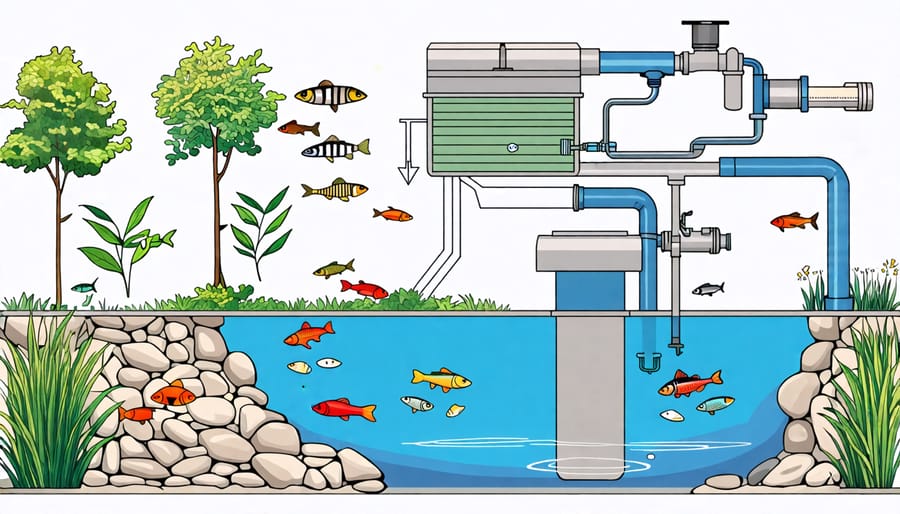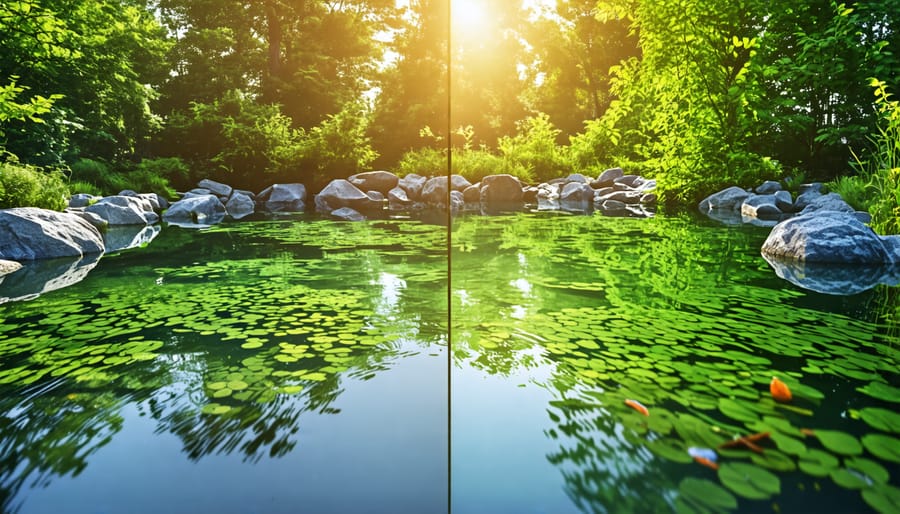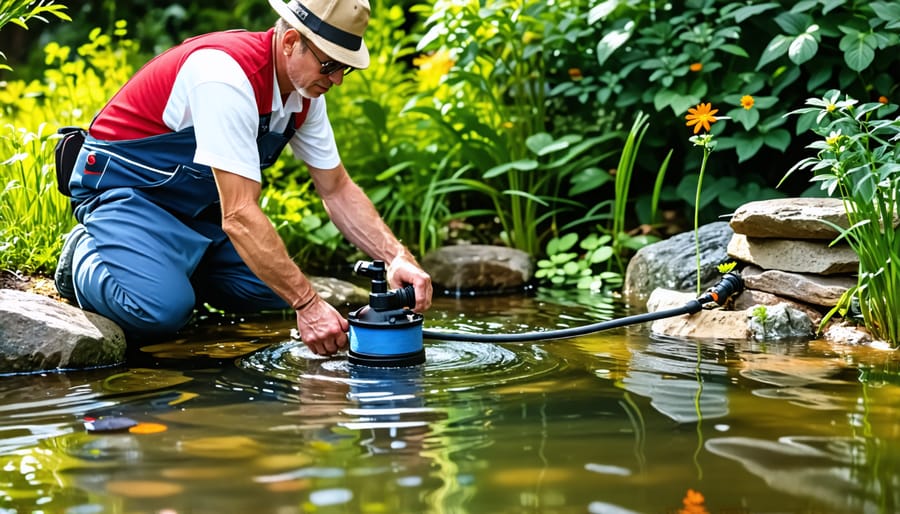
Crystal Clear Pond Secrets: The Power of External Filters
Choose an external pond filter sized appropriately for your pond volume to effectively remove debris and maintain clear water. Position the filter above the waterline near your pond with tubing connecting it to the pond for optimal water circulation and easy maintenance. Regularly clean the filter media by rinsing it with a garden hose to remove accumulated debris and ensure efficient operation. Inspect the filter and tubing periodically for any clogs or damage, and replace components as needed to keep your pond filtration system functioning properly.
Understanding External Pond Filters
Components of an External Filter
An external pond filter typically consists of several key components that work together to keep your pond water clean and clear. The first essential part is the pump, which draws water from the pond and pushes it through the filtration system. Pumps come in various sizes and flow rates to accommodate different pond volumes.
Inside the filter housing, you’ll find the filtration media – the heart of the cleaning process. This often includes mechanical filtration pads or sponges that trap debris and solid waste. Biological media, such as ceramic noodles or bio-balls, provide surface area for beneficial bacteria to grow and break down harmful compounds like ammonia and nitrites.
Many external filters also feature a UV clarifier – a special bulb that emits ultraviolet light to eliminate green water caused by free-floating algae. As water passes by the UV light, it damages the algae cells and causes them to clump together for easier removal by the filter.
Additional components may include flow control valves to adjust the rate of filtration, a self-priming feature for easy startup, and a backflush cleaning mechanism to simplify maintenance. Some advanced filters even offer separate chambers for different types of media, allowing for a customized filtration setup tailored to your pond’s specific needs.
By understanding the role of each component in an external filter, you can make a more informed decision when selecting the right system for your pond. With proper setup and maintenance, an external filter will help you achieve a beautiful, balanced ecosystem that you can enjoy for years to come.

Mechanical vs Biological Filtration
External pond filters utilize both mechanical and biological filtration to keep pond water clear and healthy. Mechanical filtration physically traps and removes solid debris like leaves, twigs, and fish waste. This is usually accomplished with filter pads, brushes, or mats that catch particulates as water passes through. Biological filtration relies on beneficial bacteria that colonize filter media to break down dissolved organic compounds and convert toxic ammonia into less harmful substances. External filters create an ideal environment for these bacteria to thrive by providing ample surface area and oxygenation. Together, mechanical and biological filtration in external filters work to clarify water, reduce maintenance, and support a balanced ecosystem. This dual approach is more effective than either type alone, making external filters a top choice for many pond owners. Even small water garden filters typically incorporate both mechanical and biological stages for optimal results.
Benefits of Using an External Filter
Improved Water Clarity
External pond filters are highly effective at removing debris, excess nutrients, and other particulates from your pond water. As water passes through the filter media, fine particles are trapped and removed, leading to significantly clearer water. With regular maintenance, external filters can keep your pond crystal clear, allowing you to enjoy the beauty of your fish and aquatic plants without unsightly cloudiness or discoloration. In addition to mechanical filtration, many external filters also include biological filtration stages that break down harmful compounds, further contributing to optimal water clarity and quality. With an external filter working hard to polish your pond, you’ll spend less time dealing with murky water and more time admiring the stunning results.

Healthier Fish and Plants
An external pond filter creates the optimal environment for fish and aquatic plants to thrive. By removing debris, excess nutrients, and harmful compounds, it maintains crystal-clear water that allows ample sunlight to reach submerged plants. Efficient filtration also eliminates toxic ammonia and nitrites, ensuring a healthy habitat for your fish. With an external filter, you’ll enjoy a balanced ecosystem where fish have plenty of oxygen to breathe and plants receive the nutrients they need to flourish. Say goodbye to murky, stagnant water and hello to a vibrant, thriving pond teeming with life. Your fish and plants will thank you for investing in their well-being!
Easier Maintenance
External pond filters make maintenance much simpler compared to built-in or submerged options. With an external filter, you can easily access all components for cleaning and servicing without having to drain the pond or disturb its inhabitants. The filter media can be quickly removed, rinsed, and replaced as needed to maintain optimal performance. This eliminates the need for time-consuming and messy pond cleanouts. External filters also typically have larger capacities than integrated designs, allowing for longer intervals between cleanings. Plus, the pump is located outside the pond, making it easy to inspect and service without getting wet. With simplified upkeep, external pond filters help you spend more time enjoying your water garden and less time maintaining it.
Choosing the Right External Filter
When selecting an external filter for your pond, consider the size of your pond, the number and types of fish you have, your budget, and the features you need. As a general rule, choose a filter rated for a pond at least 50% larger than yours to ensure adequate filtration capacity.
Estimate your pond’s volume in gallons or liters. Large ponds over 1,000 gallons will require more powerful filters compared to smaller ponds under 500 gallons. Also, consider future plans for expanding your pond or adding more fish.
The fish population influences filtration needs. Koi and other heavy-feeding fish produce more waste, requiring robust filtration. For ponds with a high fish load, opt for filters with higher flow rates and multiple filtration stages.
Determine your budget for the initial filter purchase and ongoing maintenance costs like replacement filter media. While higher-priced filters often offer advanced features and better performance, there are reliable options for various budgets.
Evaluate the features of different external filters. Look for models with multi-stage filtration that include mechanical, biological, and potentially chemical filtration. A built-in UV clarifier is beneficial for combating green water algae. Automatic self-priming and easy maintenance access are valuable conveniences.
Consider noise levels, especially if your pond is near seating areas or neighbors. Some external filters operate more quietly than others. Read product reviews from other pond owners to gauge real-world performance and reliability.
Assess the filter’s flow rate, which should turn over the entire pond volume at least once every 2 hours. Adjust this based on fish load and pond conditions. A higher flow rate is better for heavy fish stocks or ponds prone to debris accumulation.
Compatibility with your pond pump is crucial. Ensure the filter’s maximum flow rate matches or exceeds your pump’s output for optimal performance. Proper sizing prevents leaks and ensures efficient operation.
By carefully evaluating your pond’s specific needs and comparing filter features, you can select an external filter that will help keep your backyard pond ideas alive and thriving with crystal-clear water. Investing in a high-quality filter suited to your setup will pay off in reduced maintenance and a healthier pond ecosystem.
Installing and Maintaining Your External Filter

Installation Basics
Installing an external pond filter is a straightforward process that can be tackled by most DIY enthusiasts. First, choose a level spot near your pond to place the filter, ensuring it’s close enough for the hoses to reach comfortably. Many opt to hide the filter behind rocks or plants for a more natural look.
Next, connect the hoses from the pond pump to the filter’s inlet and the filtered water outlet back to the pond. Secure the connections with hose clamps to prevent leaks. If your filter has a built-in UV clarifier, plug it into a nearby GFCI-protected outlet.
Before starting the filter, fill it with the recommended filter media per the manufacturer’s instructions. This may include mechanical filtration pads, bio-media for beneficial bacteria, and activated carbon for chemical filtration.
Now you’re ready to prime the pump and turn on the filter! Be sure to check for leaks at the connections and monitor the water flow. You may need to adjust the flow rate or clean the pump intake if the flow seems weak.
Over the first few weeks, keep an eye on the filter’s performance and your pond’s water clarity. You may need to rinse or replace the mechanical filter media more frequently during this break-in period as it traps excess debris. With proper installation and regular maintenance, your external pond filter will help keep your water crystal clear and your fish happy and healthy!
Maintenance Schedule
To keep your external pond filter functioning optimally, establish a regular maintenance schedule. Weekly, check the pre-filter and remove any debris to maintain healthy water flow. Every 2-4 weeks, rinse the biological media in pond water (not tap water which can harm beneficial bacteria). Depending on your pond’s needs, fully clean the media every 1-3 months.
Annually, disassemble and deep clean the entire filter, inspecting parts for wear. Don’t forget to clean the pump and hoses too. Stick to your schedule, but let your pond’s condition guide you – murky water or clogging may indicate extra cleaning is needed.
Routine pond maintenance takes some effort but it’s key to a healthy, crystal-clear pond. With each cleaning, take a moment to appreciate your pond’s beauty and the satisfying results of your labor! Your diligence will be rewarded with a low-maintenance, naturally-balanced ecosystem.
Conclusion
In conclusion, external pond filters are a game-changer for pond enthusiasts seeking crystal-clear water and a thriving aquatic ecosystem. By efficiently removing debris, excess nutrients, and harmful pollutants, these powerful filtration systems maintain optimal water quality with minimal effort. The transformative benefits of a serene pond are within reach when you invest in a high-quality external filter tailored to your pond’s specific needs. From enhanced water clarity and reduced maintenance to healthier fish and lush aquatic plants, the advantages of external filtration are undeniable. So, whether you’re a seasoned water gardener or a novice pond owner, upgrading to an external pond filter is a wise choice that will elevate your pond’s beauty, functionality, and overall enjoyment for years to come. Take the first step towards achieving the pond of your dreams by exploring the world of external filtration today!
